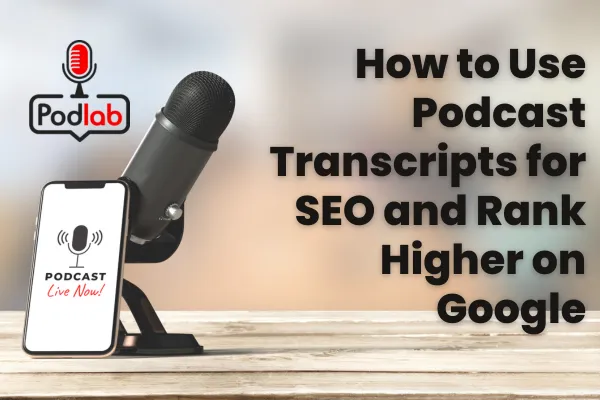PodLab Blog Posts

How to Use Podcast Transcripts for SEO and Rank Higher on Google
How to Use Podcast Transcripts for SEO and Rank Higher on Google
Podcasting is a powerful content marketing tool, helping businesses build authority, generate leads, and engage their audience. However, if you're not leveraging podcast SEO strategies, you're leaving valuable search traffic on the table.
Google doesn’t index audio content, which means podcast episodes alone won’t show up in search results. That’s where podcast transcripts come in. By converting spoken content into text, you unlock a massive SEO opportunity, making your podcast discoverable, searchable, and repurposable across multiple platforms.
In this guide, you’ll learn how to use podcast transcripts for SEO, boost visibility, and turn your podcast into a lead-generating machine.
Why Podcast Transcripts Matter for SEO
Search engines rely on text to understand and rank content. Since audio files can’t be crawled, podcasts without transcripts miss out on organic traffic. By adding search-optimized transcripts, you can:
Rank for relevant podcast keywords your audience is searching for.
Increase website traffic by making your content searchable.
Enhance user engagement by providing multiple ways for people to consume your content.
Improve accessibility, making your content available to those who prefer reading.
A well-optimized podcast transcript makes it easier for Google to understand your content, helping you rank higher in search results.
1. Publish SEO-Friendly Transcripts on Your Website
A simple yet highly effective podcast SEO strategy is publishing transcripts on your website. However, to maximize SEO impact, you need to structure them properly:
Format transcripts like a blog post with headings, bullet points, and key takeaways.
Use podcast SEO keywords naturally, focusing on terms your audience searches for.
Optimize meta tags and descriptions, ensuring the title and URL include relevant keywords.
Break up long text with images, quotes, and timestamps for better readability.
For example, instead of just pasting a raw transcript, structure it into an engaging, search-optimized blog post. This way, your content works both for search engines and readers.
2. Convert Transcripts into SEO-Optimized Blog Posts
Instead of posting transcripts as-is, repurpose them into blog content that ranks higher on Google. Here’s how:
Expand on key topics to target long-tail podcast SEO keywords.
Improve readability by formatting content into an article-style post.
Create shareable content for social media and newsletters.
For example, if your podcast episode is titled "How to Generate Leads Through Podcasting", transform it into a blog post like "5 Ways to Generate High-Quality Leads Through Your Podcast". This helps you rank for specific search queries while delivering extra value to your audience.
3. Repurpose Podcast Transcripts for More Content Marketing
Your podcast transcript is a goldmine of repurposable content that can drive more traffic. Here’s how to use it:
LinkedIn posts: Extract key insights and turn them into bite-sized social media content.
YouTube descriptions: If your podcast is on YouTube, adding a transcript helps with SEO rankings.
Email newsletters: Summarize key takeaways and drive traffic back to your website.
SEO-friendly social captions: Use snippets from your transcript for Instagram, Twitter, and Facebook.
By repurposing podcast content, you increase visibility, engagement, and lead generation across multiple platforms.
4. Optimize Podcast Transcripts for Featured Snippets
Google loves FAQ-style content because it directly answers user queries. If your podcast covers industry-related topics, extract insights from your transcripts and create an FAQ section.
For example, if your podcast focuses on business podcasting, you could answer:
What’s the best way to use a podcast for lead generation?
How can I increase podcast visibility on Google?
What are the best podcast SEO strategies?
By structuring your transcripts into Q&A formats, you improve your chances of ranking in Google’s featured snippets, driving more traffic to your site.
5. Boost Internal Linking with Podcast Transcripts
Internal linking is an essential part of SEO strategy. With transcripts, you can:
Link to related podcast episodes within the text.
Direct visitors to your services, lead magnets, or case studies.
Improve dwell time by keeping users engaged with relevant content.
A well-linked transcript strengthens your website’s SEO, increasing engagement and search visibility.
6. Use AI Tools to Optimize Podcast Transcripts Faster
Manually optimizing transcripts can be time-consuming, but AI tools can speed up the process. Using AI-powered transcription software, you can:
Automatically clean up filler words for better readability.
Identify key SEO topics for blog posts.
Extract quotes and insights for social media content.
By leveraging AI-driven SEO tools, you ensure your podcast transcripts are polished, keyword-rich, and search-friendly without spending hours on manual editing.
Final Thoughts: Turn Your Podcast into an SEO Powerhouse
Podcasting isn’t just about audio content—it’s about creating a content ecosystem that drives traffic and generates leads. By optimizing your podcast transcripts, you can:
✅ Boost podcast SEO and rank higher on Google
✅ Increase website traffic and visibility
✅ Repurpose transcripts for content marketing success
✅ Enhance accessibility and engagement
If you’re looking to increase podcast visibility, optimize transcripts, and turn your podcast into a lead-generating machine, we can help.
Ready to elevate your business with a professional podcast? Whether you're just starting out or looking to take your podcast to the next level, PodLab can help you become a market leader and attract more clients. Book a FREE podcast consultation call with us today and let's discuss how we can make podcasting a powerful tool for your business. Click here to schedule your session now!
Happy podcasting!

Navigation
Contact Us
© 2023 All Rights Reserved
Podlab.agency

